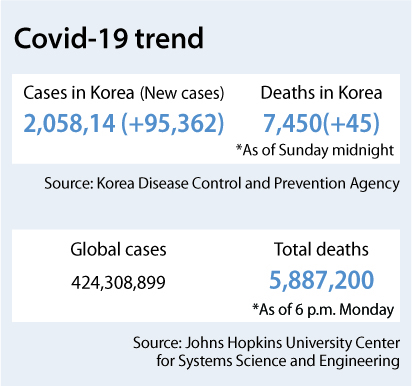Record infections will make Covid endemic: officials
![Educational staff prepare Covid-19 home testing kits at a middle school in Incheon on Monday to give to students ahead of the spring semester. [NEWS1]](https://koreajoongangdaily.joins.com/data/photo/2022/02/21/3760f86a-7dea-4089-8d89-1dcf1f2473bc.jpg)
Educational staff prepare Covid-19 home testing kits at a middle school in Incheon on Monday to give to students ahead of the spring semester. [NEWS1]
Despite the worst wave of coronavirus infections yet, health authorities Monday said the spike in new cases is part of the process of Covid-19 becoming an endemic disease.
"Given its characteristics, the Omicron spread is very fast, but has low severity and fatalities,” Son Young-rae, senior epidemiological strategist at the Central Disaster Management Headquarters, told reporters on Monday.
“[The increase in critical cases] is a natural phenomenon, so there is no need to overreact and be anxious,” he added.
After months of the Delta variant’s dominance, Omicron was declared the dominant strain in Korea since the third week of January. Fueled by its much higher transmissibility, the country’s daily virus cases have jumped up to over 100,000.
On Monday, infections dipped slightly to 95,362, but were still close to 100,000. With Monday’s addition, the total caseload crossed the 2 million mark — just two weeks after passing 1 million.
Along with the rise in infections, patients who were in critical condition reached 480, the highest figure in a month.
Despite severe cases climbing back to near 500, health authorities stressed that the fatality rate of Omicron is remaining at a “stable state.”
According to Son, the fatality rate of Delta was about 0.7 percent, while that of Omicron was 0.13 percent over the two weeks from Jan. 16 to 29 — and close to 0 percent among people under 50. For fully vaccinated people, Omicron’s fatality rate is below the seasonal flu's, the health official said.
“It is necessary to go through a big wave once and to shift into endemic,” Son said, adding, “In this process, it is better for Omicron to spread rather than the [more fatal] Delta variant.”
Oh Myoung-don, a professor of infectious disease at Seoul National University Hospital, who leads the National Medical Center‘s committee for clinical management of emerging disease control, said if the public is not intimidated by Omicron, it can pass by like the flu.
“Putting the Covid-19 infections figure at the center is not suitable for the Omicron era,” Oh said in a recent interview with the JoongAng Ilbo. “The most important indicator is fatalities, and then, in order, critically ill patients, hospitalized patients, and finally confirmed patients.”
Oh cited the case of Seoul National University Hospital. The hospital had 84 admitted Omicron patients in January and February, but none of them deteriorated enough to be sent to the intensive care unit (I.C.U.). There were no deaths either. After three days, all the patients got better and said they wanted to go home. If it were the Delta variant, Oh believes at least one out of three patients in their 80s would have ended up in the I.C.U.
Other hospitals saw a similar phenomenon.

But health authorities don't agree with lifting the mask mandate.
“Until we confirm the peak of the wave, the basic plan is to operate the existing public health measures more conservatively and ease them after [the peak],” explained Son.
“Wearing a face mask is the best preventive measure, and easing it is a matter to be reviewed at the end,” he added.
Recently, most U.S. States except for Hawaii ended mask mandates following similar decisions made in countries such as Italy, France and Britain.
Regarding the peak of the current trend, a new forecast was revealed on Monday that the country might report up to 270,000 daily infections around mid-March.
During a regular briefing on Monday, KDCA commissioner Jeong Eun-kyeong said, “After collecting forecasts conducted by domestic and foreign researchers, the peak of the wave was widely predicted from the end of February to March, while the daily tally ranged from 140,000 to 270,000 people."
The KDCA had predicted earlier on Feb. 7 that daily infections could reach from 130,000 to 170,000 at the end of this month, but the arrival of the peak was slightly pushed back while the size grew in the new forecast.
“Once [the virus situation] stabilizes after passing the peak, there are parts that need readjustment such as in social distancing, vaccine passes and the medical response system,” said Jeong, “and talks are underway for Covid-19 strategies after the peak.”
Under current social distancing measures, gatherings are capped at six while business facilities such as restaurants and cafes have to close at 10 p.m. nationwide. The measures are effective until March 13.
BY SEO JI-EUN, SHIN SUNG-SIK [seo.jieun1@joongang.co.kr]










with the Korea JoongAng Daily
To write comments, please log in to one of the accounts.
Standards Board Policy (0/250자)